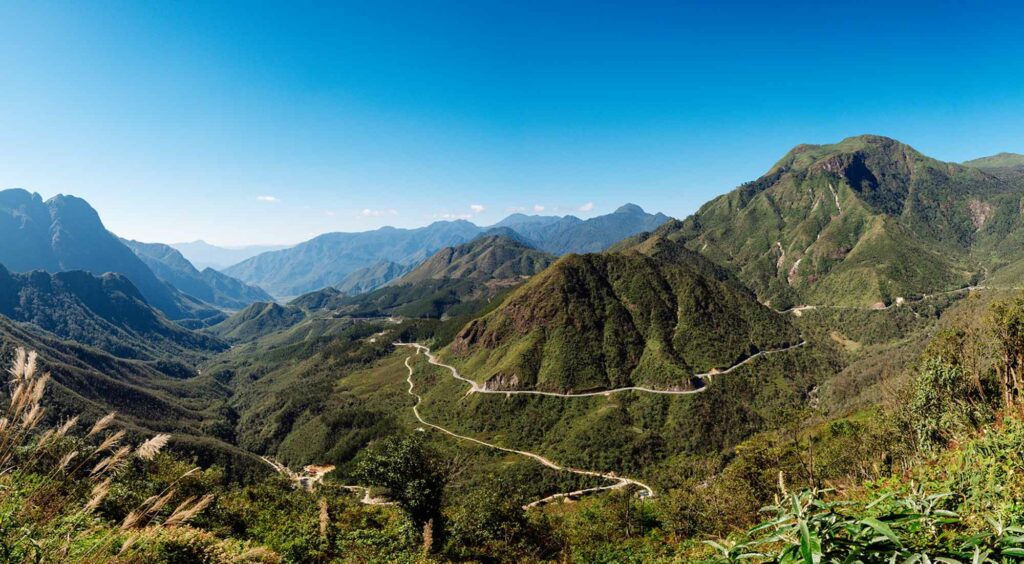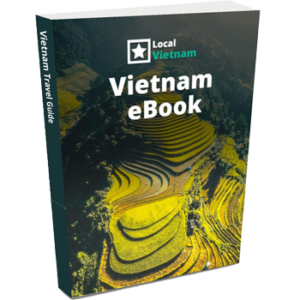What is the Tram Ton pass?
Tram Ton Pass, often referred to by its local name Đèo Ô Quy Hồ, is the highest mountain pass in Vietnam, reaching an elevation of around 1,900 meters (6,233 feet). It lies on National Highway 4D, connecting Lao Cai Province and Lai Chau Province, and sits just a short drive west of Sapa town—making it one of the most popular scenic spots in the region.
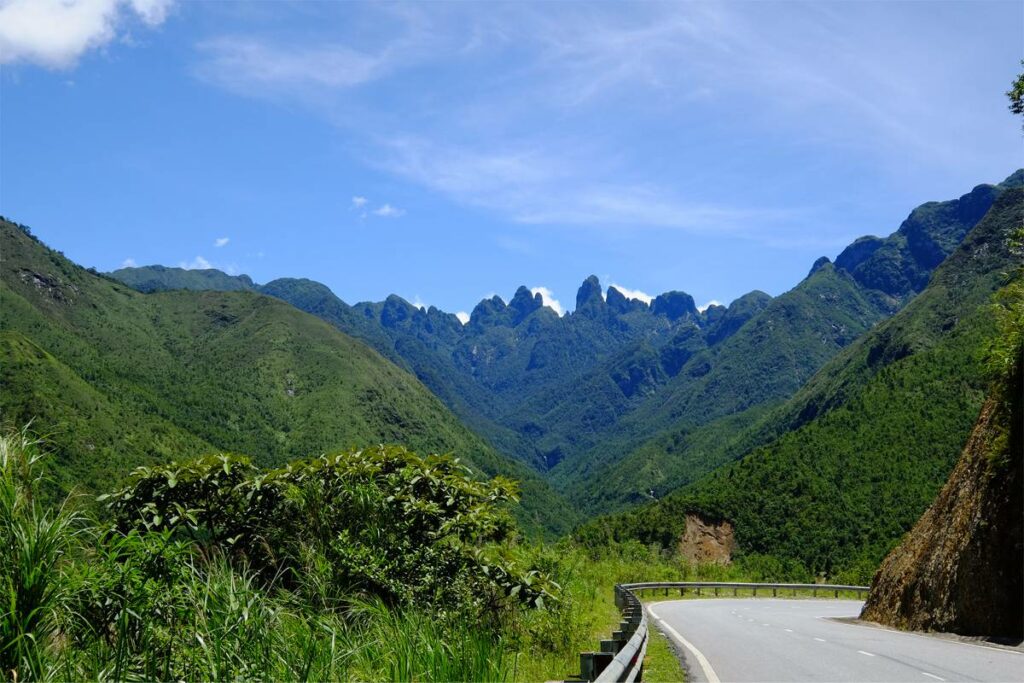
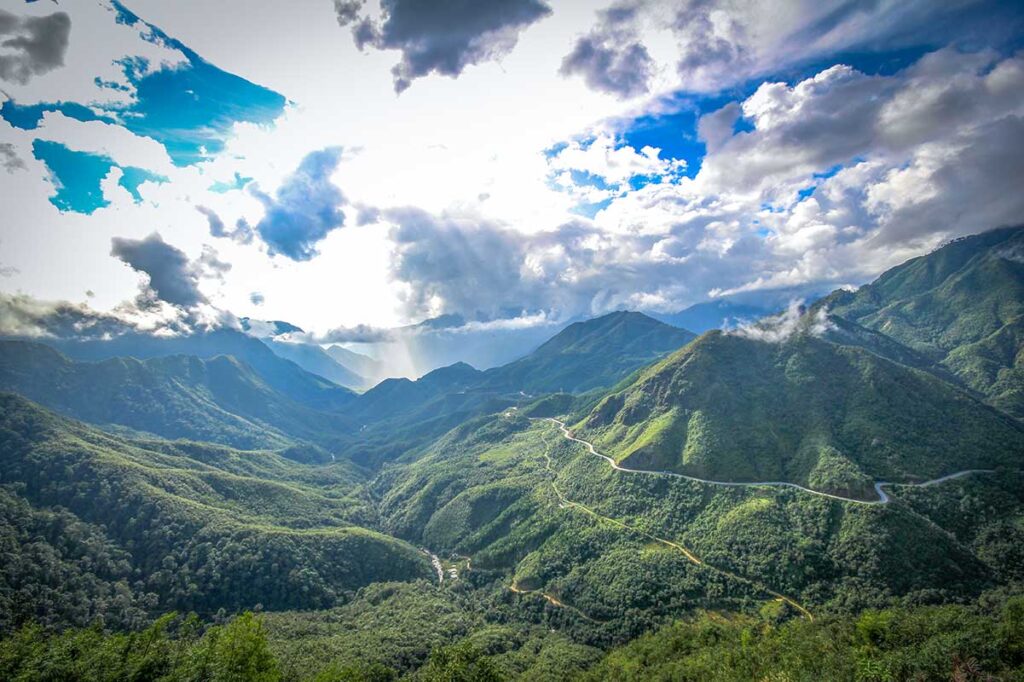
This pass is not only a vital transportation link through the Hoang Lien Son mountain range, but also a natural highlight thanks to its incredible altitude and panoramic views. It runs along the northern edge of Hoang Lien National Park, offering glimpses of deep valleys, high ridges, and—on clear days—Fansipan, the tallest peak in Indochina.
Although the total length of the pass is around 50 kilometers, the most visited viewpoint area is close to Sapa, often called Heaven’s Gate. This nickname reflects both the breathtaking scenery and the weather contrast: one side of the pass is often misty and cool (the Sapa side), while the other is warmer and sunnier (Lai Chau side).
Over the years, the area around the main viewpoint has become more developed, with small cafés, souvenir stands, and photo props—some charming, others a bit kitschy. Despite these additions, the landscape remains stunning, and visiting Tram Ton Pass is still one of the best half-day trips you can make from Sapa. Whether you come by motorbike or private car, it’s an unforgettable ride through some of Vietnam’s most spectacular mountain scenery.
How to get to Tram Ton Pass?
Tram Ton Pass is only about 15 km from Sapa town, making it one of the easiest scenic routes to explore in the area. The journey takes around 15–25 minutes, depending on your transport and stops. Below are the main ways to get there—with pros and cons to help you choose the best option for your trip.
Tram Ton Pass visit in a Sapa tour
Many of our multi-day Sapa tours include a half-day trip over Tram Ton Pass, often combined with visits to Love Waterfall, Silver Waterfall, or local markets.
Taking a taxi
TTaking a taxi is the quickest and most straightforward way to reach the top of Tram Ton Pass. The ride costs around 100,000 to 150,000 VND (roughly $5–6 USD) for a round trip. If you’re just planning to go to the viewpoint, enjoy the scenery for a few minutes, and return to town, this is a fine option. Most taxi drivers are used to this kind of short trip and don’t mind waiting while you take a few photos—waiting time for brief stops is typically not charged extra.
However, taxis operate more like point-to-point services. If you plan to make multiple stops along the way, such as visiting Love Waterfall or the Glass Bridge, or want to take your time, a taxi isn’t the most convenient choice. In that case, it’s better to arrange a private car with a fixed itinerary.
Private car with driver
A car with driver offers much more flexibility than a taxi. Instead of running on a meter, this service is arranged in advance with a fixed price based on your chosen itinerary. You can plan a half-day outing that includes Tram Ton Pass as well as stops at places like Love Waterfall, Silver Waterfall, and the Glass Bridge—all located along the same mountain route. It’s a comfortable and easy way to explore the area, especially if you’re traveling with others or prefer a slower pace.
This option is ideal if you want a proper sightseeing experience, with time to enjoy each stop without having to negotiate or watch the clock. It also works well if you’re planning to include the pass as part of a wider day tour around Sapa.
Arranging a driver in Sapa
Need help booking a private car with driver or creating a full itinerary around Tram Ton Pass? We can arrange everything for you—flexible routes, English-speaking support, and reliable local drivers.
Motorbike (Self-drive)
If you’re comfortable on two wheels, riding a motorbike to Tram Ton Pass is a great way to enjoy the scenery up close. Motorbike rental in Sapa costs around 100,000–150,000 VND per day, and the road to the pass is generally in good condition. Unlike the chaos of big cities like Hanoi, traffic here is calmer—but you’ll still need to be careful, as the pass sees a fair number of fast-moving minivans and tour buses.
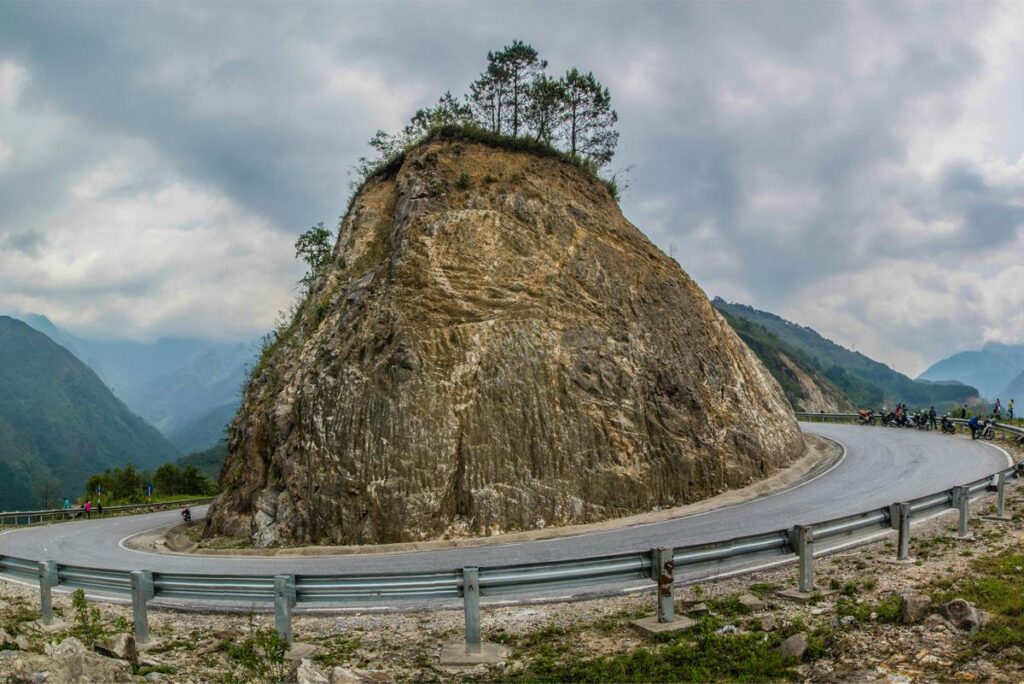
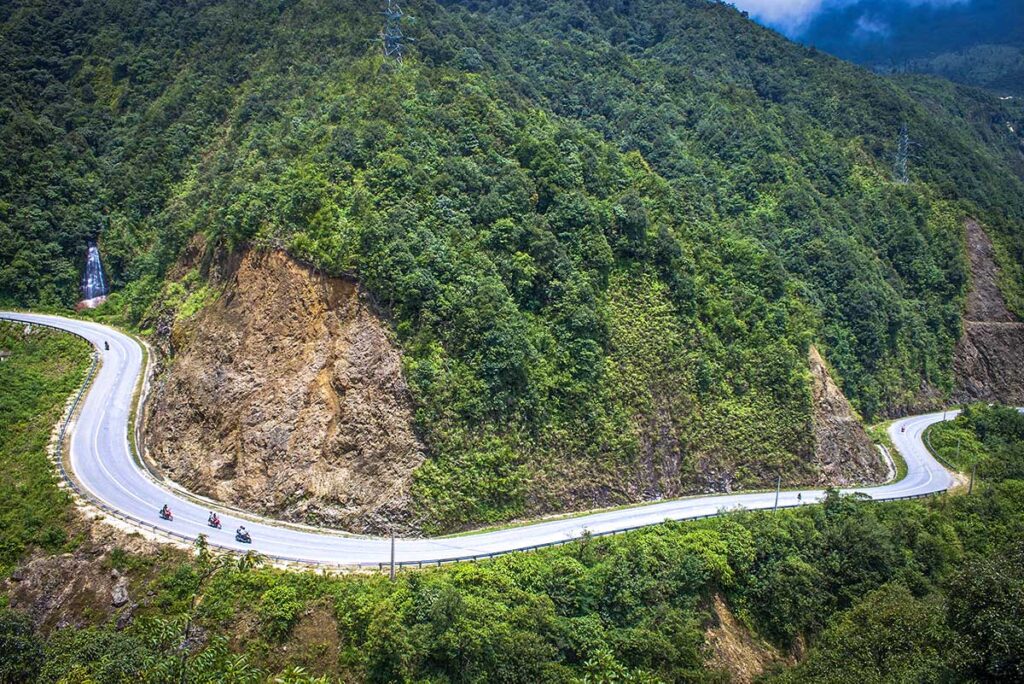
This option is only recommended for travelers who already have riding experience and a valid license. The curves, elevation, and weather conditions along the pass can be tricky, especially for beginners.
A few things to look out for when driving a motorbike over Tram Ton Pass:
- The roads through the mountains of Vietnam are not a place to start learn how to drive a motorbike. It is only recommended for experienced and confident drivers
- Be aware that driving without a Vietnamese drivers licence is not legal. Police often tolerate it, but not always and you might not be fully insured in case of an accident.
- There are vans driving through these mountainous curcy roads, so it is important to keep driving on the right as much as possible when you are on a motorbike.
Motorbike tour (Riding on the back)
If you want the adventure of a motorbike without having to drive yourself, a motorbike tour with a local guide is a great alternative. You’ll ride on the back while the guide navigates the route, allowing you to focus on the views. It’s safer, more relaxing, and ideal for those without a license or riding experience, while still providing a fun and immersive way to explore Tram Ton Pass and the surrounding area.
Highlights along the Tram Ton Pass
The Tram Ton Pass is more than just the highest mountain pass in Vietnam—it’s a scenic journey through dramatic landscapes, misty peaks, and cultural sights. While the main viewpoint is a destination in itself, the real charm lies in the stops you can make along the way.
The highlights below are listed in the order you’ll encounter them when traveling from Sapa toward the top of the pass—not by importance, but by route. If you take your time, this short stretch of road becomes one of the most rewarding half-day trips in northern Vietnam.
1. Sapa Tea Hills (Sapa Sakura Tea Plantation)
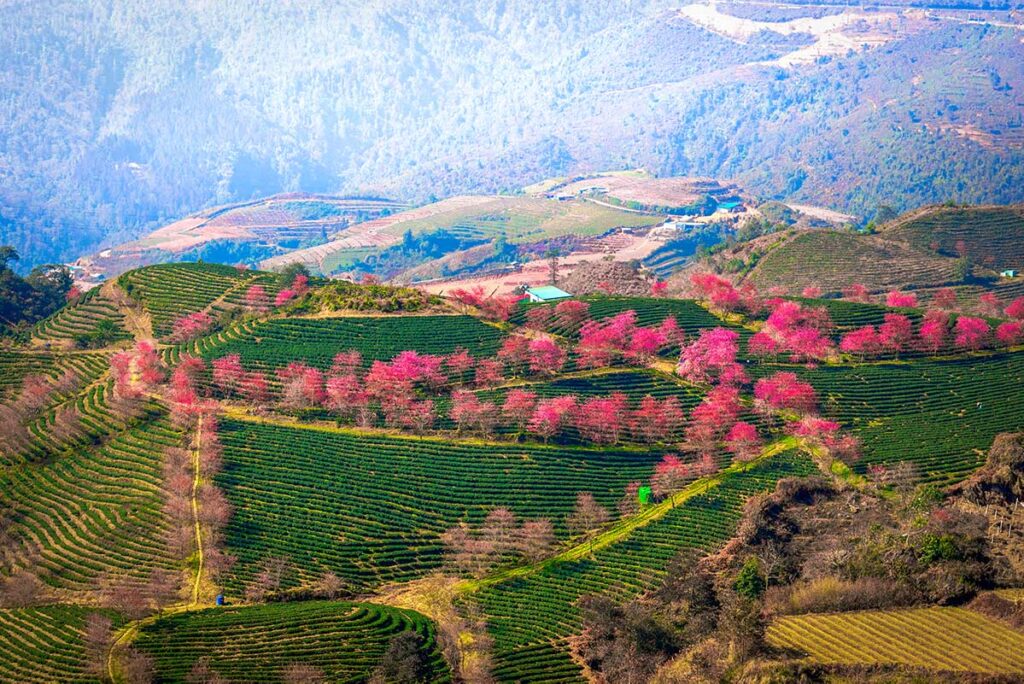
Just a few kilometers outside of Sapa, you’ll pass the Sapa Tea Hills—a landscape of gently sloping green fields planted with neatly trimmed tea bushes. In spring, blooming sakura trees add a pink touch to the scenery, making it one of the most photogenic spots near town.
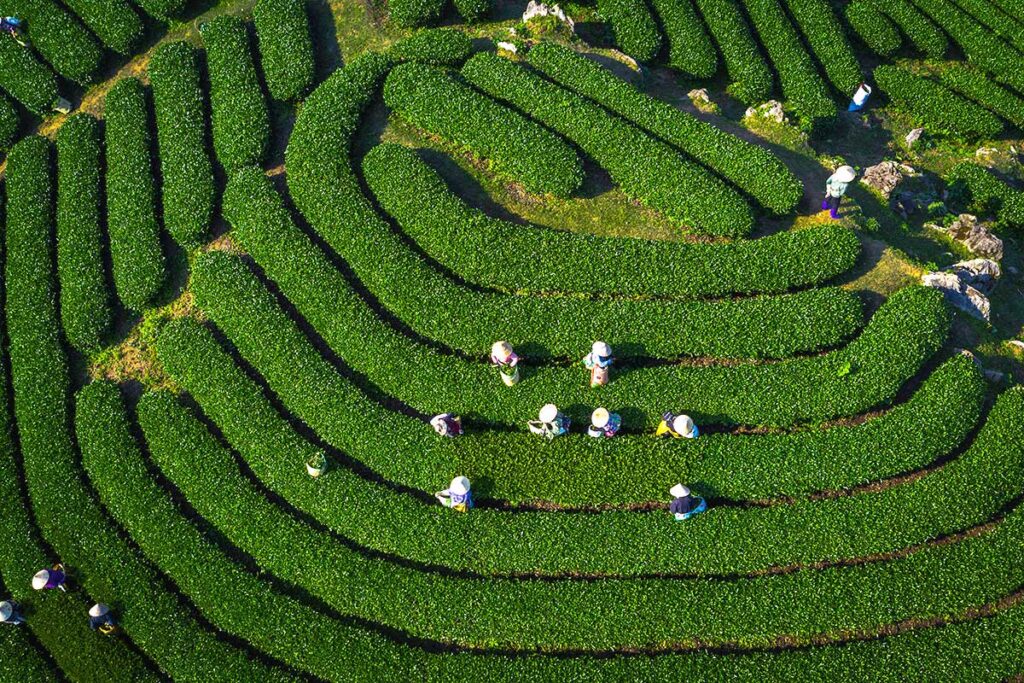
It’s a peaceful and scenic place to stretch your legs or take a short break on the way up the pass. There’s no entrance fee, and it’s easy to stop for a few quick photos before continuing your journey.
Read our guide to the Sapa Tea Hills
2. Silver Waterfall (Thac Bac)
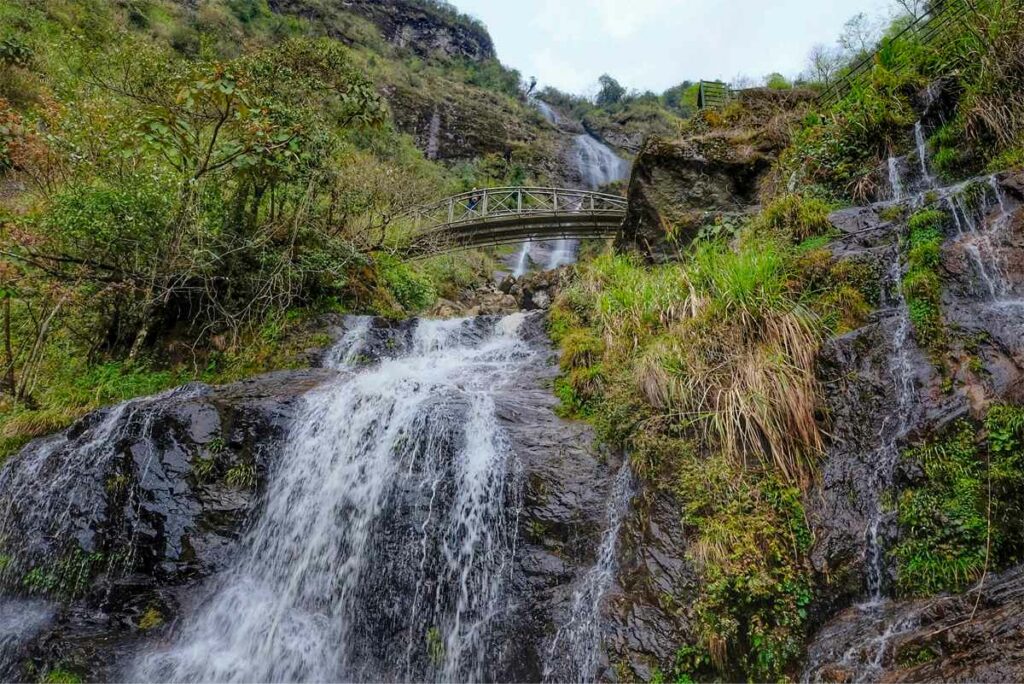
The Silver Waterfall is the first major stop along the Tram Ton route. This impressive cascade drops around 200 meters down the cliffside, often creating a misty spray and loud roar that you can hear from a distance.
It’s located directly beside the main road, so you can’t miss it. Many travelers stop to take photos from the roadside, but you can also pay a small fee to climb the stairs for a closer view.
See details on visiting the Silver Waterfall
3. Love Waterfall (Thac Tinh Yeu)
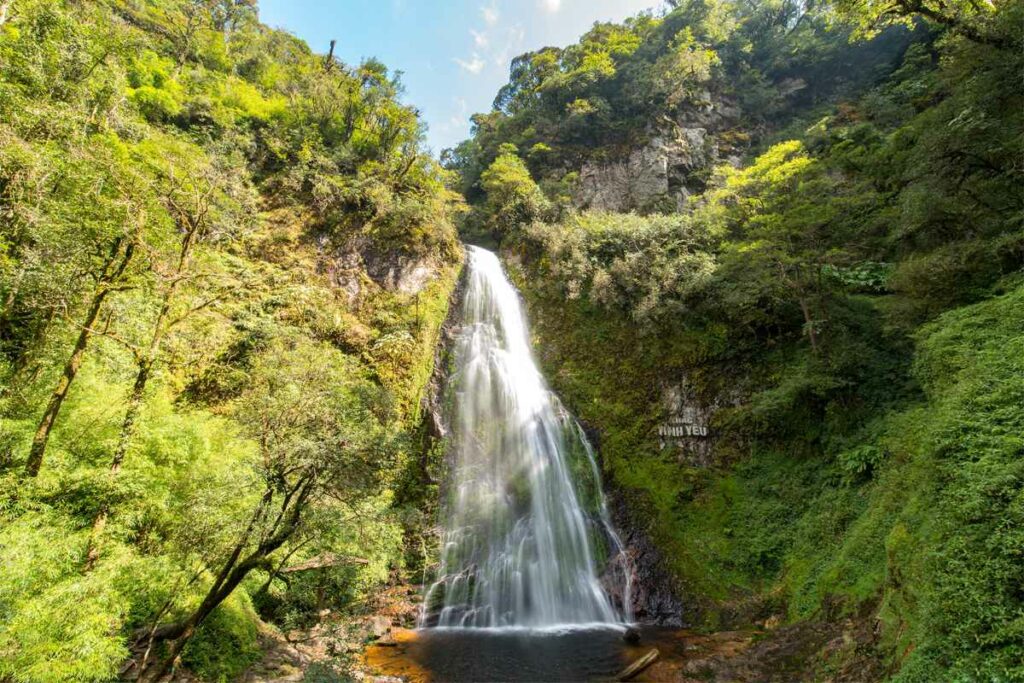
Further along the route, the Love Waterfall offers a quieter and more immersive nature experience. Hidden in the forest, it’s reached by a peaceful 30-minute walk through Hoang Lien National Park. The trail itself is just as enjoyable as the destination, surrounded by lush greenery and birdsong.
Because it’s not directly next to the road, fewer travelers stop here—which makes it an ideal spot if you’re looking to escape the crowds. The trail is paved and easy to follow, with a modest entrance fee at the gate.
Plan your visit to the Love Waterfall
4. Fansipan trekking trailhead
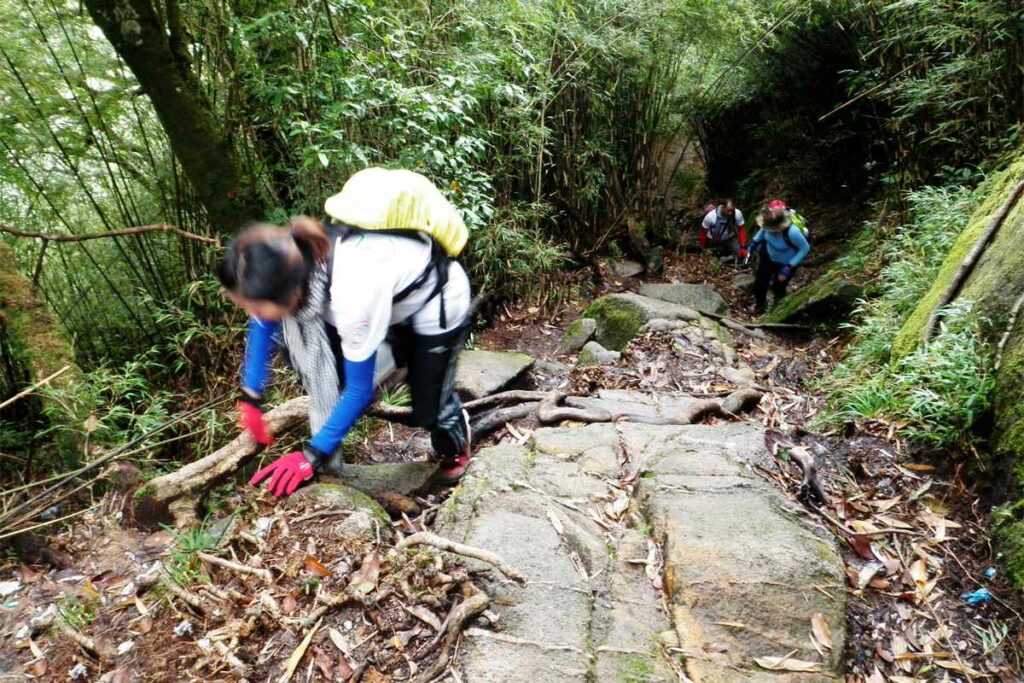
Just beyond the gate to Love Waterfall, you’ll find the starting point of the Fansipan trekking trail. This is the beginning of the challenging but rewarding hike up Vietnam’s highest peak, winding through dense forest, steep terrain, and overnight camping areas on the way to the summit.
Trekking here is only permitted with a licensed local guide, and the standard route takes two days to complete. Fit and experienced hikers sometimes do it in one day, but it’s a tough climb.
Note: The cable car to Fansipan departs from a different location closer to Sapa and is not part of the Tram Ton Pass route.
5. Tram Ton Pass Viewpoint (Heaven’s Gate)
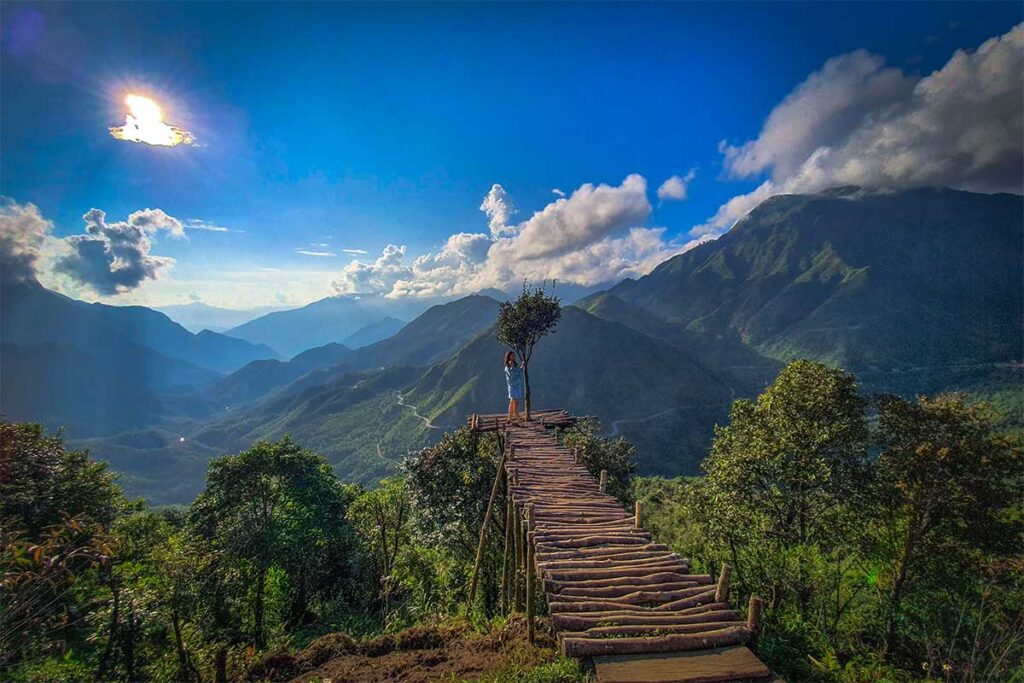
At 1,900 meters above sea level, this is the highest point of the Tram Ton Pass and the place most people associate with the name “Heaven’s Gate.” From here, you’ll get sweeping views of the Hoang Lien Son mountain range and the deep valleys below.
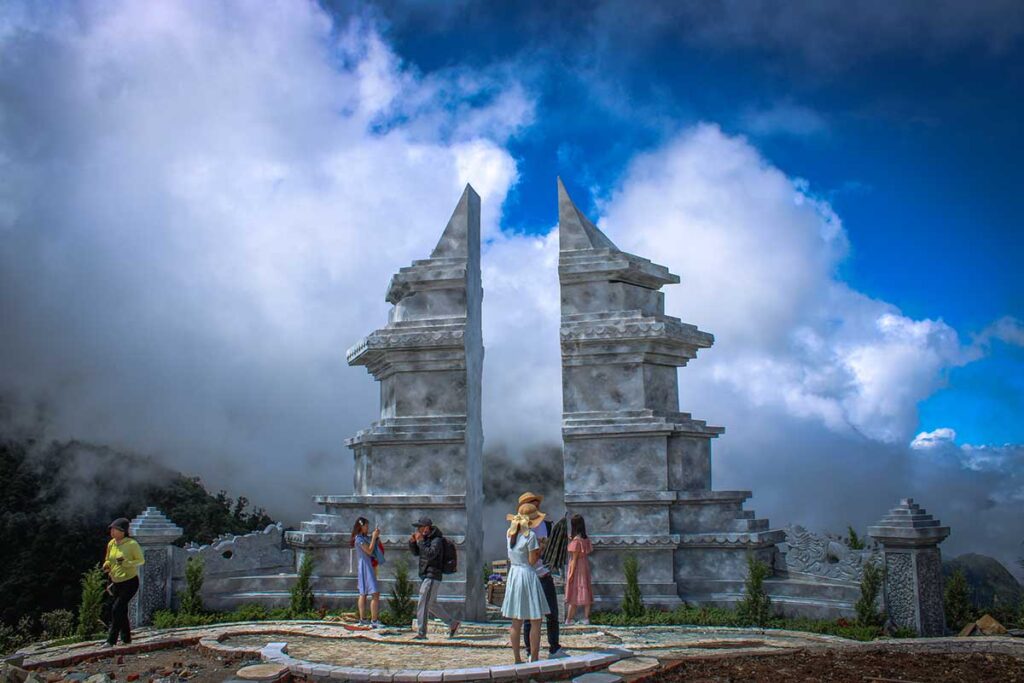

Several platforms and cafés now dot the area, and some viewpoints charge a small entrance fee. While a bit commercialized, the scenery is still spectacular—especially around sunrise or sunset. You may also notice a stark contrast in weather between the Sapa and Lai Chau sides, with Lai Chau often drier and sunnier.
6. Glass Bridge & Tourist Park (Sapa Skywalk / Rong May Glass Bridge)
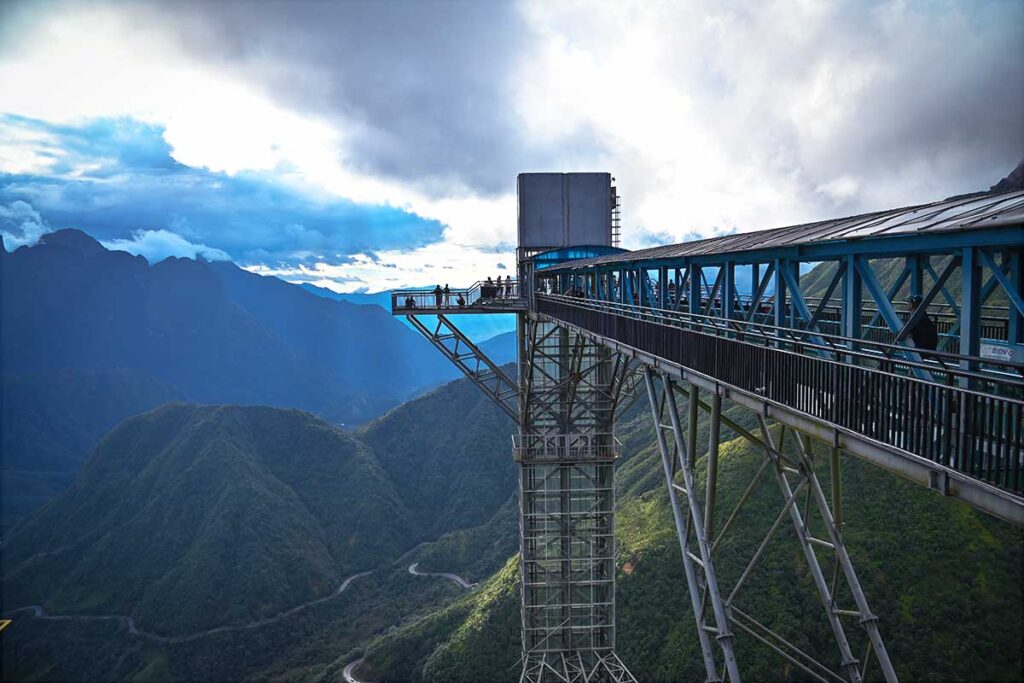
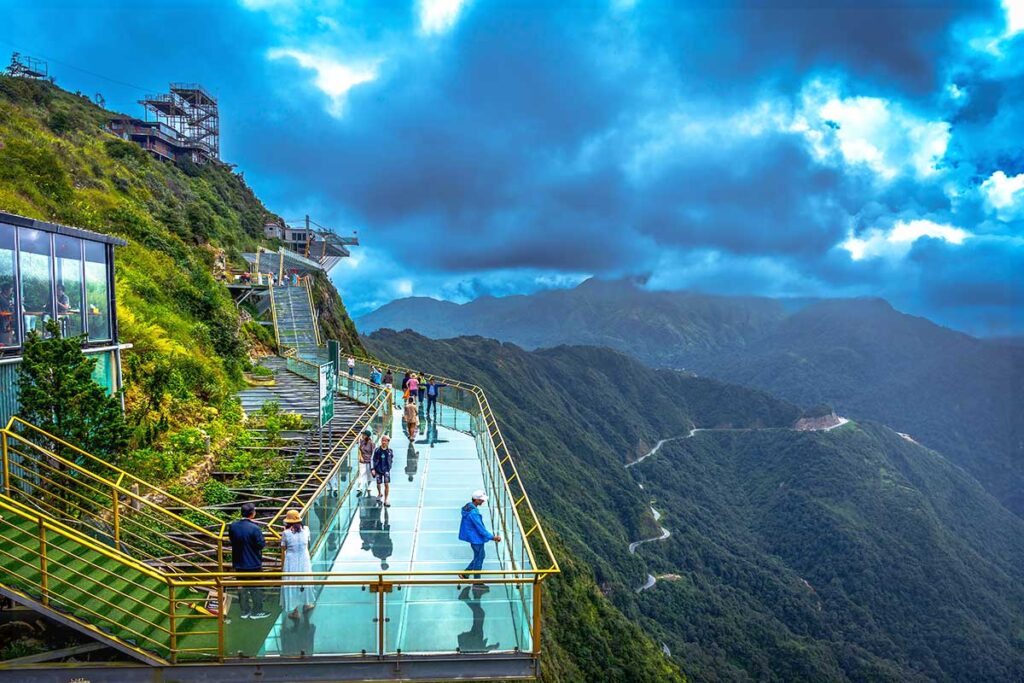
About 5 km past the Tram Ton Pass, this modern viewpoint adds a bit of adrenaline to your mountain trip. The glass-bottomed bridge extends out over the cliffside, offering dizzying views of the valley below, backed by towering peaks.
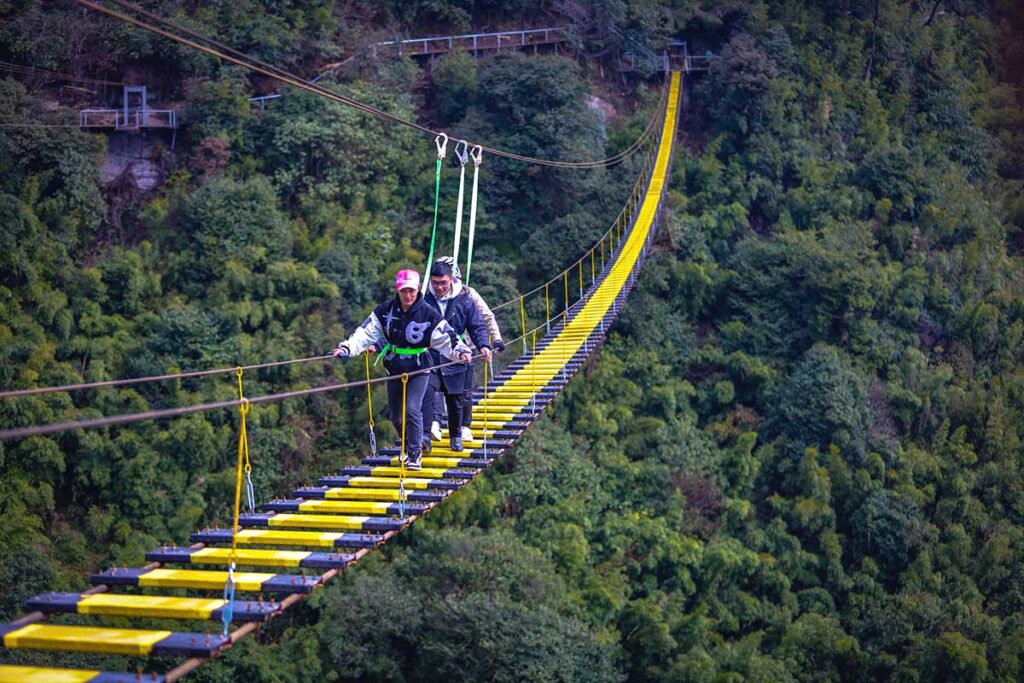
Entrance is around 500,000 VND and includes access to the elevator, plus optional adventure add-ons like ziplining or biking on a high wire. The surrounding park features cafés and themed photo zones with statues and artificial gardens—some might find it a bit kitschy, but the views are hard to beat.
Check our full guide to the Glass Bridge experience
7. Lonely Tree Viewpoint
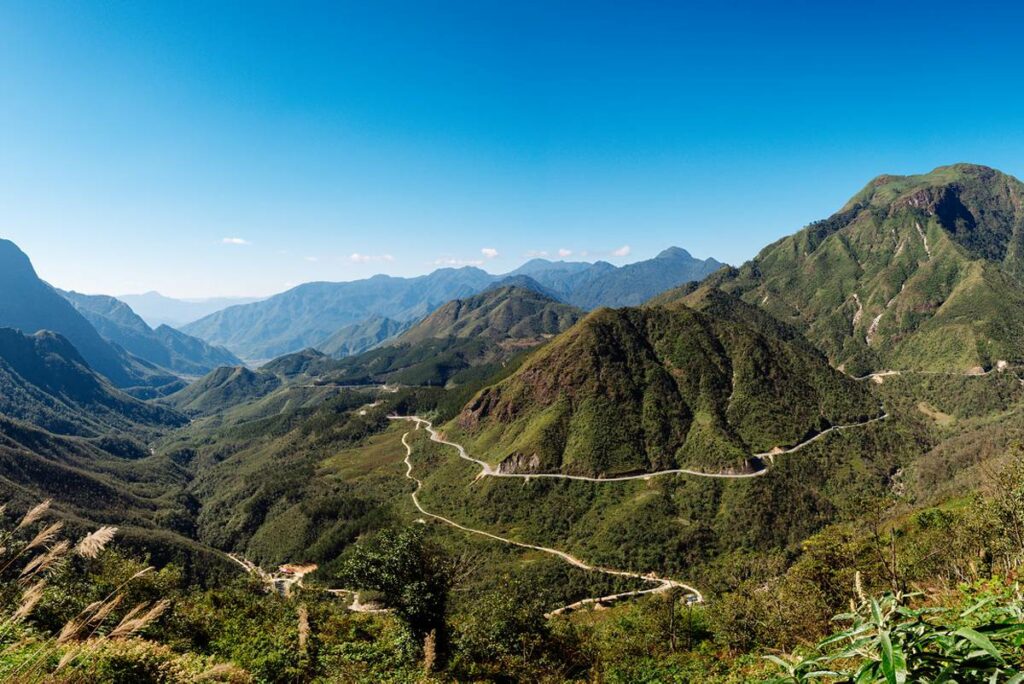
This simple yet striking stop features a single tree perched beside the curving mountain road—framed by panoramic views of valleys, cliffs, and layered peaks. It’s become a favorite Instagram spot for its minimalist beauty and dramatic setting.
There’s a small café nearby offering drinks and light snacks, and a entrance fee is usually charged (around 20,000 VND). It’s a quick but worthwhile stop, especially if you like to take photos.
8. Chu Va Peak Viewpoint
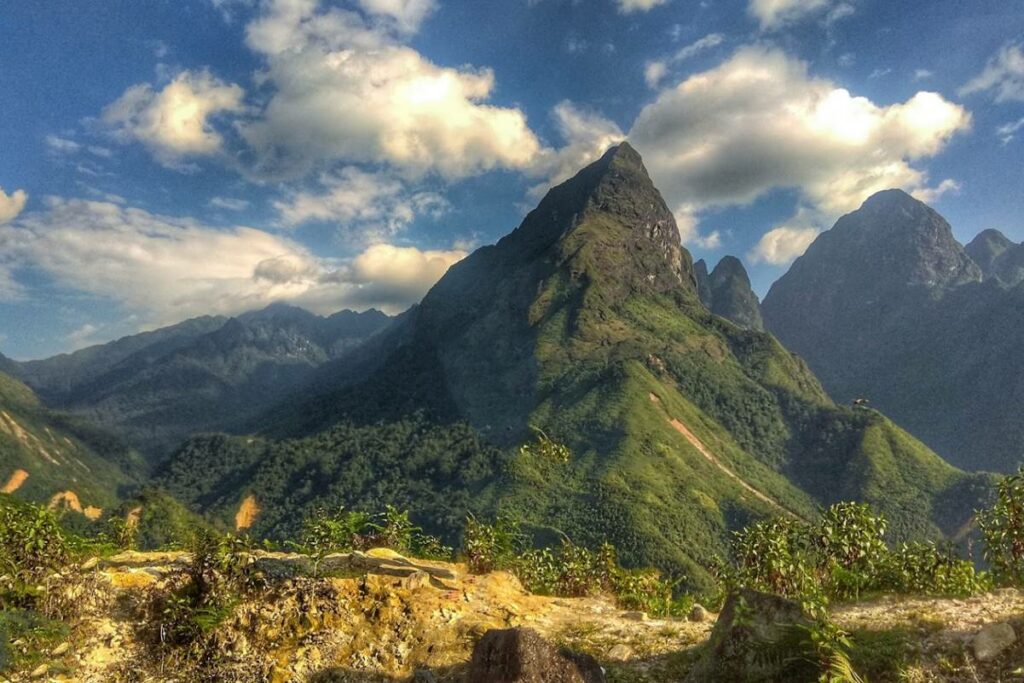
Continue about 9 km past the Glass Bridge and you’ll reach one of the most scenic and quiet spots along the route. This viewpoint faces Chu Va Mountain, one of Lai Chau province’s tallest peaks, known for its rugged shape and green surroundings.
From here, you’ll get beautiful views over rice fields and forested mountains, with far fewer crowds than at the main viewpoints. It’s an ideal spot to take a break or turn around if you’re not continuing all the way to Lai Chau.
Best time to visit
You can visit the Tram Ton Pass all year round. Keep in mind that during the winter months of December and January it can get quiet cold in Sapa. Make sure when you are planning to drive a motorbike by yourself to bring warm clothes. In the summer there is a lot more change on rain, so best to bring a rain jacket with you. Read here more about the best time to visit Sapa.
The pass is high up in the mountains, so there is always a good change that there are a lot of clouds, which will block some of the stunning views. The best time to take photos is at sunset or dawn. Make sure to check the weather forecast before you go out.
Tips for exploring Tram Ton Pass
Make the most out of your visit with these practical tips—whether you’re stopping by for the view or planning a longer half-day adventure.
1. Avoiding crowds
Tram Ton Pass is close to Sapa and offers some of the best views in the region, so it can draw a decent number of visitors—especially on weekends and holidays. While the road itself rarely feels crowded, the viewpoints and photo spots can. If possible, go early in the morning for a quieter experience. Also, most people turn back after the Glass Bridge—just continuing a bit further often means having the road and views almost to yourself.
2. Go beyond the pass
Technically, Tram Ton Pass marks the border between Lao Cai and Lai Chau provinces. While most travelers turn around at the top, heading deeper into Lai Chau rewards you with peaceful roads, rice terraces, and fewer tourists. It’s a great way to explore lesser-visited parts of northern Vietnam. For ideas, check out our full Lai Chau travel guide.
3. Prepare for colder temperatures
Sapa is already known for its cool climate, and Tram Ton Pass climbs even higher—up to 1,900 meters. It can feel noticeably colder on top, especially on cloudy or windy days. In winter, it can get seriously chilly. Even if you’re traveling by car, remember that you’ll want to get out and walk around, so bring a jacket or extra layer.
4. Bring cash
A few roadside cafés along the way are perfect for a quick coffee with a view—but they usually only take cash. Some of the best photo spots, including private viewpoints or “Heaven’s Gate” platforms, also charge a small entrance fee (usually around 20,000–30,000 VND). Don’t count on card payment working here.
5. Fansipan climb only with a guide
While the trail to the top of Fansipan starts near Tram Ton Pass, climbing on your own is not allowed. The route is long, steep, and often covered in fog. People have gotten lost before. A licensed guide is required, and most treks take two days with an overnight stay in camp. One-day climbs are possible, but only for very fit and experienced hikers.
6. Check the weather forecast
The pass is all about the views—but clouds often roll in and block everything. The weather here changes fast and is more unpredictable than in town. Forecasts aren’t always accurate for the pass itself, but generally, sunny or partly sunny days are best. Right after a rain shower can also be a great time to go, as clouds often lift and give way to dramatic views.
Is Tram Ton Pass worth visiting?
Yes—if the weather is clear, the views from Tram Ton Pass are some of the most stunning in all of northern Vietnam. The dramatic mountain landscape, deep valleys, and sense of open space make it a highlight of the region. On a sunny or partly sunny day, it’s absolutely worth the trip.
But if the pass is covered in clouds, it can feel a bit underwhelming. Unlike Muong Hoa Valley, where even on cloudy days you can still see local life, rice fields, and nearby hills, Tram Ton Pass is all about far-reaching views. When those views disappear into the fog, so does most of its appeal.
Some parts of the pass, like the Glass Bridge or Heaven’s Gate cafés, may feel overly commercial or kitschy—built more for selfies than scenery. Still, you can skip those spots and enjoy the natural beauty in quieter areas or on the short walk to Love Waterfall, which is a peaceful and rewarding stop in any weather.
In short: On a clear day, don’t miss it. On a cloudy day, consider whether it’s worth the time—or focus on lower areas like Muong Hoa Valley instead.
